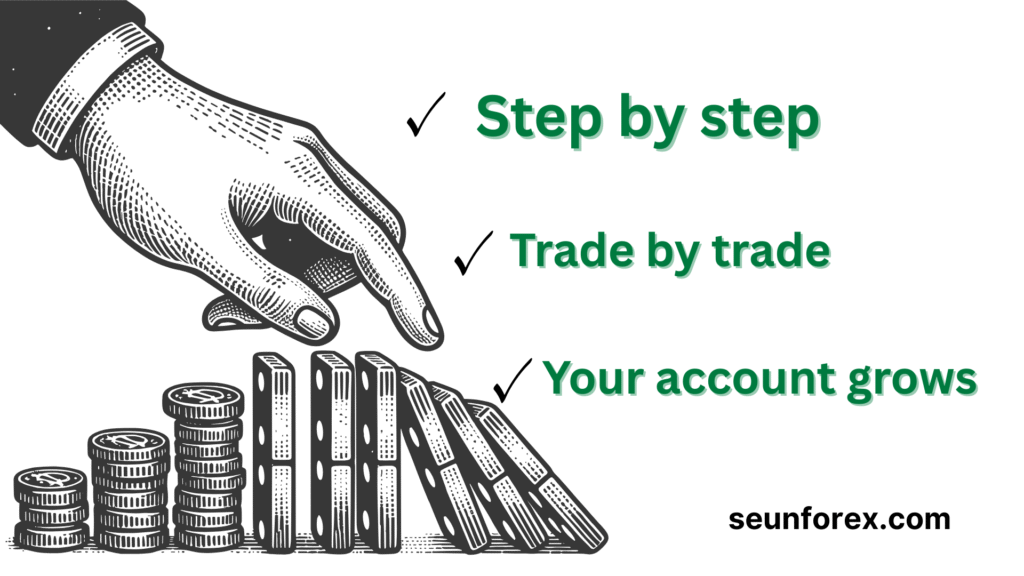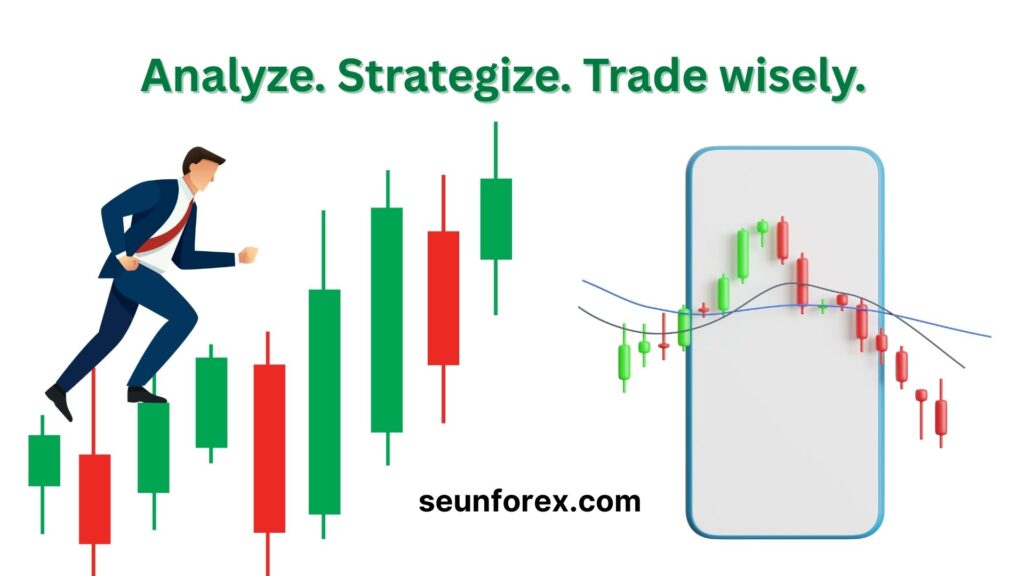
📉 A Rollercoaster Year Ahead
First year forex trading can be both exciting and overwhelming. In your first year of forex trading, expect early wins, painful losses, and a steep learning curve. Many beginners imagine constant profits, but reality is different: volatility, mistakes, and emotional challenges dominate the early months.
The key takeaway? Patience is your strongest ally:
“Consistency matters more than immediate results; every loss is a lesson if you study it.”
Many forex trading beginners enter the market with high hopes. They read a few strategies online, see others making money on social media, and assume success will be quick. The reality? It’s a marathon, not a sprint. Profits in the first year are secondary to experience, discipline, and emotional growth.
🧮 Demo vs. Real Trading: Know the Difference
Starting with a demo account is essential, especially for first year forex trading, but it comes with caveats. A demo account allows forex trading beginners to:
- Understand how to open and close trades.
- Practice basic forex risk management.
- Test trading platforms and charting tools.
But here’s the catch: emotions in a demo account are muted. You won’t feel the fear of losing real money or the stress of seeing your capital evaporate overnight. Many traders who excel in demo trading fail in live accounts because they underestimate the psychological toll.
“Trading with real capital exposes your mind more than your strategy,” especially in your first year of forex trading.
🧵 Lesson 1: Master Risk Management First
Before thinking about profits, learn to protect your account. Early traders often make the fatal mistake of risking too much on a single trade, chasing large gains.
Practical guideline for first-year traders:
- Risk 1–2% of your capital per trade.
- Set clear stop-loss levels.
- Avoid over-leveraging, even when brokers offer 1:500 or more.
Example: Imagine starting with $1,000. Risking 5% per trade means a $50 loss if the market moves against you. In contrast, risking 1% keeps your account safe, allowing you to survive multiple losing streaks. The lesson is survival—without it, no learning occurs.
🛡️ Lesson 2: Psychology Over Strategy
Even the best strategies fail if emotions take control. Fear, greed, and impatience cause traders to:
- Enter trades too early.
- Exit trades too late.
- Chase losses (revenge trading).
- Ignore their trading plan entirely.
First-year forex traders must realize: the market will punish undisciplined behavior. Trading psychology is just as important as strategy. Journaling trades, reviewing mistakes, and having strict rules can shield you from yourself.
Practical exercise: Track your emotions for every trade. Rate stress, confidence, and impatience on a scale of 1–10. Over time, patterns emerge. You’ll see which emotions trigger mistakes and which support good trading decisions.
🧠 Lesson 3: Learn to Cut Losses Quickly
Inexperience during your first year forex trading often leads forex trading beginners to hold onto losing trades, hoping for reversals that may never come. This behavior, often called “letting losses run,” is one of the most common rookie mistakes.
Example: A trader opens a EUR/USD long at 1.1200, sets a stop-loss at 1.1180, but hesitates and removes it. The market drops to 1.1150, erasing multiple days of gains. In first year forex trading, learning to cut losses quickly is far more valuable than chasing profits.
Key principle: Profitability is not about never losing; it’s about never letting losses compound and controlling forex risk management effectively.
🧾 Lesson 4: Focus on One Strategy, Not Many
The temptation to master every indicator, currency pair, or timeframe is strong among beginners. The result? Confusion, inconsistent results, and unnecessary stress.
In your first year forex trading, it’s better to focus on:
- One trading style (day trading, swing trading, or position trading).
- One currency pair (or a small basket of pairs).
- One strategy you can execute consistently.
Practical tip: Document the rules of your strategy clearly—entry, exit, stop-loss, take-profit, and risk per trade. This clarity reduces mistakes under pressure and lays the foundation for more advanced techniques, such as a swing trading guide approach later on.
🏦 Lesson 5: Keep a Trading Journal
A journal transforms experience into knowledge. Record:
- Entry and exit points.
- Trade rationale.
- Emotions and thoughts.
- Mistakes and lessons learned.
Over time, the journal reveals trends. Maybe EUR/USD trades perform better in certain sessions, or perhaps you overtrade after wins. Data-driven insights allow you to improve systematically.
🛍️ Lesson 6: Expect Growth in Steps, Not Leaps

Many beginners expect explosive account growth. The reality is that progress is incremental. Early gains may be small; early losses may feel catastrophic. The focus should be on learning and building good habits:
- Consistency beats big wins.
- Discipline compounds faster than luck.
- Emotional resilience grows over months, not days.
“Small consistent wins compound faster than occasional home runs.”
Chapter 1: The First Months – Learning the Basics
Your first months in forex trading are about understanding what you don’t know. Many beginners underestimate the depth of knowledge required.
Key fundamentals:
- Currency pairs: Majors, minors, and exotics.
- Pips, lots, leverage, and margin.
- Bid-ask spreads and swap rates.
Practical example: A trader thinks they bought EUR/USD at 1.1000 and sold at 1.1050. Sounds like a 50-pip gain, right? But they ignored the spread of 2 pips and slippage. Actual profit? 48 pips. Small details like these matter in real trading.
Tip: Use a demo account for 2–3 months to practice these basics, but simulate real conditions—risk real percentages of virtual capital, not arbitrary lot sizes.
Chapter 2: Risk Management in Depth
Many first-year traders fail due to poor risk management rather than strategy flaws.
Essentials:
- Risk per trade: 1–2%.
- Max daily loss: 3–5% of capital.
- Max weekly loss: 5–10% of capital.
Mini case study: A trader starts with $1,000. They risk 5% per trade ($50). After 5 consecutive losses, their account drops to $750—a 25% drawdown. If they had risked 1%, the account would be $951. Survival keeps learning alive.
Exercise: Calculate your risk per trade for a $2,000 account using different percentages. Document potential drawdowns and mental tolerance.
Chapter 3: Trading Psychology
Your mind is the real battlefield during your first year forex trading. Many forex trading beginners struggle with common psychological challenges, such as:
- Fear of missing out (FOMO).
- Overconfidence after early wins.
- Anxiety during losing streaks.
Developing strong trading psychology is critical to long-term success. Without emotional control, even the best strategies fail.
Exercise: Before each trade, write down:
- Why you are entering the trade.
- The worst-case outcome.
- Your emotional state.
Over time, journaling trains your brain to separate decisions from emotions and strengthens discipline in first year forex trading.
Example: A trader enters GBP/USD long after two consecutive wins, ignoring their trading plan. The market reverses sharply. Reviewing the journal reveals the mistake: overconfidence, not strategy failure. By addressing emotional triggers, forex trading beginners can improve decision-making and reduce avoidable losses.
Chapter 4: Developing a Strategy
Consistency is key. Beginners often switch strategies after one loss or gain.
Tips for first-year traders:
- Keep it simple.
- Focus on one timeframe.
- Test thoroughly in a demo before going live.
Example of a simple swing trade strategy:
- Look for trend direction on daily chart.
- Enter retracement using 1-hour chart.
- Risk 1% per trade, target 3–5% gain.
Rationale: By keeping rules simple and quantifiable, emotional decision-making is minimized.
Chapter 5: Analyzing Trades

A trade journal alone isn’t enough for first year forex trading. To truly improve, you must analyze:
- Win rate
- Average risk-to-reward (R:R)
- Drawdowns
- Entry vs. exit timing
Example: Over 50 trades, a trader wins 20 and loses 30. The average R:R is 1:3. Despite a 40% win rate, profits are positive. The key lesson: profitability depends on R:R, not just the number of wins.
For forex trading beginners, analyzing trades systematically helps identify patterns in both strategy and personal behavior. Over time, this turns experience into actionable insights.
📌 Further Reading: Learn how to build a sustainable trading career for long-term success and understand the mindset and habits needed to thrive in forex beyond your first year.
Chapter 6: Growth and Plateau
Account growth must be managed carefully. Many beginners make the mistake of increasing lot sizes after a few wins, inviting disaster.
Tips for first-year forex traders:
- Scale only after consistent performance.
- Avoid revenge trading after losses.
- Respect drawdowns—they are inevitable.
Example: A $500 account grows to $800 over 6 months. The trader risks $50 per trade, experiences losses, but follows rules. Discipline ensures growth, not luck.
Managing growth during your first year forex trading sets the foundation for long-term success. Even small accounts can compound steadily when proper forex risk management and emotional control are applied.
Chapter 7: Year-End Reflections and Next Steps
After 12 months, review your journey as a forex trading beginner:
- How consistent were your trades?
- Did you follow your trading plan?
- What emotions caused mistakes?
- How can you improve in year two?
Key takeaways for first-year forex traders:
- Protect capital above all.
- Discipline matters more than strategy.
- Emotional control compounds profits over time.
- Focus on learning, not just gains.
Final words: Trading is a skill, not luck. Your first year is an investment in mindset, habits, and resilience. Master this foundation, and profits will follow naturally.
“Treat your first year as an investment in your trading mindset—profits will follow when your skills and discipline mature.”
For a deeper understanding of building habits and strategies that last, check out our guide on sustainable trading career for long-term success.